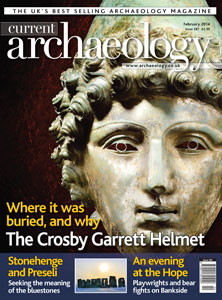News of the Crosby Garrett helmet’s discovery in 2010was swiftly tempered by disappointment when the museum seeking to acquire it was outbid at auction. With attention focusing on the helmet’s modern fate, there was a danger that its Roman-era disposal would be eclipsed. Now work at the findspot has established that Roman Crosby Garrett was a thriving farming settlement. What does this mean for our view of the helmet?
The Preseli Hills in Wales are increasingly central to attempts to deduce the meaning of Stonehenge. In this issue, the SPACES programme reflects on the fruits of over a decade of their survey and excavation in the region. Could it be that Medieval beliefs about the remarkable properties of springs gushing from Preseli outcrops hold the key to understanding why Neolithic people transported the bluestones 220km to Wiltshire?
Bankside was also once a somewhat soggy environment. It was notorious for its 14th-century brothels, with attempts to clean up the area in the 1540s opening the door to what was seen as a far more salubrious sport: bear-baiting. Recently published excavations expose the plight of the animals involved.
Rather more genteel delights are the focus of a new study of Norfolk gardens. Historic gardens only arrived on the heritage protection radar due to the determination of a World War II codebreaking veteran: we discover how Mavis Batey switched her attention from Bletchley to parks and gardens, for the benefit of all.
FEATURES/n
CROSBY GARRETT/n
Exploring the helmet’s burial place
This stunning Roman cavalry helmet caused a stir when it was discovered in 2010, in an apparently empty Cumbrian field. Now new research around the findspot has uncovered evidence of a contemporary settlement, and a possible monument raised over the place where the helmet was interred.
STONEHENGE AND PRESELI/n
Exploring the meaning of the bluestones
Although often overshadowed today by the monument’s dramatic sarsens, the Stonehenge bluestones were significant enough for prehistoric builders to source them from Wales. But what were they for? We examine the latest research.
EXCAVATING BANKSIDE/n
London’s cruel pleasureground
Today Bankside is best known as the home of the Globe theatre, but when Shakespeare’s plays were first being performed, the area was notorious for its brothels, alehouses, and animal-baiting. What light have recent excavations shed on these seedier entertainments?
IN AN ENGLISH COUNTRY GARDEN/n
Norfolk’s horticultural heritage
We pay tribute to Mavis Batey, Bletchley Park codebreaker and pioneer of garden history, and explore some of the Medieval parks and ornate gardens that have been preserved thanks to her enthusiasm.
NEWS/n
Investigating the Lincoln sarcophagus; Great Pyramids of Northumbria; Farm footprints and funerary food beneath a Cotswold carpark; Emerson’s Green: live and let dye; Mining Newcastle’s prehistoric past; Taming the Weald wilderness; Hunting King John’s palace in Sherwood Forest
/n
REGULARS/n
Conference
Updated details of the timetable for Current Archaeology Live! 2014, as well as interviews with our three nominees for Archaeologist of the Year.
Opinion
A Bronze age boat trip with Keith Parfitt of Canterbury Archaeological Trust
Reviews
Pottery in Archaeology; Blood of the Provinces; Perceptions of the Prehistoric in Anglo-Saxon England
Sherds
Chris Catling’s irreverent take on heritage issues
Odd Socs
The English Folk Song and Dance Society

